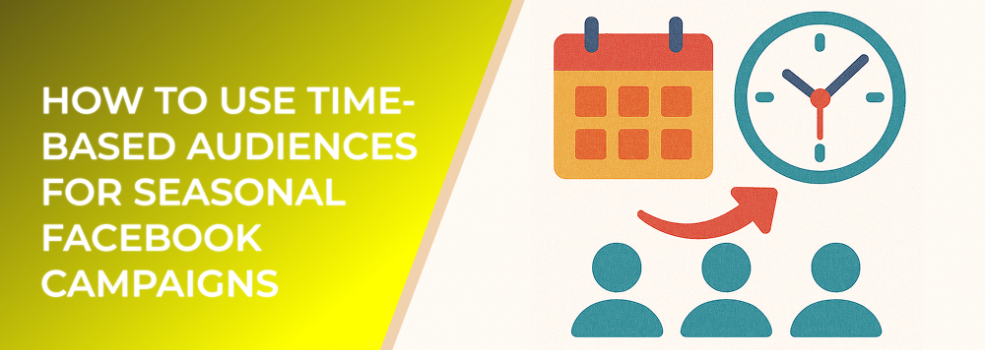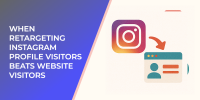Seasonality can swing CPMs, CTRs, and conversion rates more than creative alone. Time‑based audiences let you target who engaged or bought during the same period last year, or within specific recency windows that predict purchase. This guide shows how to build seasonal cohorts, set the right refresh cadence, map creative to buying windows, and measure uplift accurately.
Why Time Windows Matter (Useful Stats)
-
Customers who purchased in the same seasonal month last year are often 2–4× more likely to buy again during that month compared to non‑seasonal buyers.
-
Recency beats volume: remarketing pools with activity in the last 0–30 days typically deliver 20–40% lower CPA vs. 31–90 day windows during peak sales.
-
Offer alignment: countdown and limited‑time messaging in the final 7–10 days before a seasonal event tends to lift CTR by 10–25% vs. generic messaging.
-
Hygiene effect: moving from manual monthly to automated weekly refresh for seasonal audiences can cut waste 10–20% by keeping suppressions and recent activity accurate.
Core Time‑Based Audience Types
-
Last‑Year Seasonal Buyers (LYSB)
-
Definition: customers who purchased during the same seasonal period last year (e.g., Nov 15–Dec 31).
-
Use cases: win‑back, VIP offers, early‑access drops.
-
-
Recent Engagers by Recency (0–7 / 8–30 / 31–60 / 61–90 days)
-
Definition: people who visited key pages, watched videos ≥50%, or added to cart inside each window.
-
Use cases: layered remarketing with escalating urgency as the season approaches.
-
-
Event‑Triggered Windows
-
Definition: sign‑ups or cart initiations within X days of the seasonal date (e.g., 0–3, 4–10, 11–30 days pre‑event).
-
Use cases: cart recovery and last‑minute “ship by” reminders.
-
-
Lapsed Seasonal Buyers (13–24 months)
-
Definition: buyers from the season two years ago who didn’t buy last year.
-
Use cases: reactivation with updated bundles or price anchors.
-
Build Workflow (Step‑by‑Step)
-
Define the seasonal calendar by region (e.g., Singles’ Day, Black Friday/Cyber Monday, local holidays, school terms).
-
Map data sources: CRM orders, pixel events, email sign‑ups, offline/POS.
-
Normalize & hash identifiers (emails lowercase/trimmed; phones to E.164; SHA‑256).
-
Create recency cohorts: 0–7 / 8–30 / 31–60 / 61–90 days for key events (ViewContent, AddToCart, Lead).
-
Build LYSB segments using last year’s seasonal ranges; create VIP (top‑quartile LTV) subsets.
-
Set suppressions: recent buyers (≤30–90 days by category), refunds/chargebacks, employees/test accounts.
-
Automate refresh: daily for suppressions and 0–7 day windows; 7–14 days for moderate‑velocity lists; monthly for LYSB.
-
Label rigorously:
Season_Geo_Source_Window_Datefor traceable testing.
Creative & Offer Mapping by Time Window
-
Early Season (30–60 days out): storytelling, bundles, early‑access sign‑ups, educational angles.
-
Mid Season (8–30 days): comparison ads, social proof, price framing, limited‑time perks.
-
Late Season (0–7 days): urgency, shipping deadlines, store pick‑up, concise benefit stacks.
-
Post Season (0–14 days after): thank‑you ads, cross‑sell kits, referral prompts.
Frequency guardrails
-
Prospecting ≤ 6–8 impressions / 7 days;
-
Remarketing mid‑funnel ≤ 8–12 / 7 days;
-
Last‑minute recovery ≤ 3–4 per day with short windows.
Budgeting & Bidding Through the Season
-
Ramp 2–3 weeks before peak; raise budgets in ≤30% steps.
-
Hold CPA by shifting spend from long‑window engagers to 0–7/8–14 day pools as the date approaches.
-
Consider ROAS or value optimization once purchase volume is stable.
Measurement Framework
Track by audience window and season tag:
-
Landing rate (click → content view) and CTR to validate message‑market timing.
-
Add‑to‑Cart Rate and Purchase CVR by window.
-
CPA/ROAS vs. seasonal target.
-
Overlap & frequency to prevent double‑serve across windows.
-
LYSB uplift: compare buyers with seasonal history vs. new buyers share.
Success targets
-
0–30d engagers: 20–40% lower CPA vs. 31–90d.
-
LYSB vs. non‑seasonal buyers: 2–4× higher conversion propensity.
-
Late‑window urgency: CTR +10–25% vs. mid‑window creative.
30/60/90‑Day Seasonal Plan
Days 0–30 (Pre‑season)
-
Build LYSB and recency cohorts; set automation; create early/mid/late creative sets.
-
Baseline KPIs and QA events.
Days 31–60 (In‑season)
-
Shift budget towards 0–7 & 8–14 day engagers and LYSB; enforce frequency caps.
-
Refresh seeds weekly; rotate creatives; confirm suppressions daily.
Days 61–90 (Post‑season)
-
Run cross‑sell and thank‑you sequences; evaluate LTV and refund rates.
-
Archive learnings; schedule next year’s LYSB build.
Troubleshooting
-
High CPM, flat conversions: collapse windows to concentrate intent; exclude overlapping audiences; prune weak placements.
-
Great CTR, poor CVR: tighten late‑window copy; surface shipping deadlines early; align landing pages with seasonal promise.
-
Audience too small: widen from 0–7 to 0–14/0–30 days; add multi‑identifier matching to grow reach.
KPI Checklist (Copy/Paste)
-
Seasonal calendar defined by geo
-
LYSB and recency cohorts built and labeled
-
Suppressions updating within 48 hours
-
Frequency within stage caps
-
Budgets ramped ≤ 30% per step
-
CPA/ROAS reporting by window and season
Suggested Reads from the LeadEnforce Blog
-
When to Refresh Custom Audiences in Facebook Ads for Better Accuracy
-
Retargeting Without Waste: Exclusions, Frequency Caps, and Creative Rotation
Takeaway
Time‑based audiences help you put the right urgency and offer in front of people at the right moment. Use last‑year seasonal buyers, rolling recency windows, and automated refresh to keep accuracy high. Pair each window with matching creative and frequency caps, and you’ll convert seasonal intent into reliable, efficient revenue.

